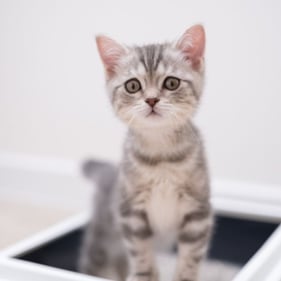If your cat is soiling outside their litter box, they are waving the red flag to tell you something is wrong. It’s either a medical issue, an emotional issue, or something about the litter box setup that isn’t meeting their needs.
A little detective work and an understanding of some of your cat’s natural, instinctual needs can help resolve litter box issues quickly.
Quick Links

To us, the litter box is just a place to pee and poop. To a cat, it’s one of the most important elements of their environment. Where a cat chooses to eliminate in the wild can actually be a matter of life and death. Too close to a freshwater source can lead to contamination and illness. Eliminating in their hunting ground can spread their scent so their prey avoids the area and they can’t hunt. And let’s not forget about predators. Cats are prey animals. Eliminating in the wild leaves them vulnerable to attack. Just because our cats are living indoors doesn’t mean those needs and instincts change, especially if there’s another pet in the home that they don’t get along with well or even a young child who can feel like a tiny predator running around making loud kid sounds. This is why your cat’s litter box setup is such an important part of stopping house soiling.
Our mission is to help save dogs' and cats’ lives through our educational content. To support our efforts, this page may contain affiliate links. We earn a commission for qualifying purchases – at no cost to you.
The overwhelming majority of pooping outside the box has a medical component. And at least half of peeing outside the box is for a medical reason. But that’s not just medical as it relates to the urinary or digestive tracts.
Cats will soil for any sort of pain or discomfort — ear infections, paw pain, arthritis, broken bones, etc. So, a thorough exam is always your first step. Sometimes it can take more than one visit to the vet because cats are great at hiding pain and can be tough to diagnose.
Even medical issues that have been resolved can be a factor in ongoing house soiling. Pain or discomfort associated with using the litter box can create a negative association with the box even after the pain is gone. That leads us to emotional causes.
All kinds of emotions can trigger eliminating outside the litter box. Fear, stress, anxiety, territorial concerns (seeing cats outside or a new cat introduced to the home), changes in routine, changes in relationships with other pets or people, new pets or babies in the home … if it can cause stress, it can contribute to going outside the litter box.
This may seem like the easy part. Anyone can buy a litter box at the store and put litter in it. But there’s so much more to meeting your cat’s litter box needs. Unfortunately, most of our human instincts on the matter are off track. And many commercial products are made more for people than for cats.
Cats have a ritual in the litter box. They don’t just hop in, pee, and hop out. They have to see what other smells are in the area, dig, spin around, sniff, dig more, spin more, then finally do their business before starting their post-pee and poop routine. They do all of this for specific reasons that make all kinds of sense if you’re a wild animal but may not make much sense to use in our homes. But when we domesticate pets from wild animals like cats, without doing any selective breeding to fade out those instinctual behaviors, we have to respect them.
And just because your cat has been using the same litter box setup for years doesn’t mean their sudden house soiling is unrelated to the box setup. Cats are great at tolerating something that isn’t ideal until other stressors build up. Then, much like humans, it’s the straw that broke the camel’s back. Something’s gotta go, and it might be using that litter box they don’t like. Be open-minded while doing your house-soiling detective work. Look at it from your cat’s perspective, not just yours.
It’s not always easy to determine whether your cat is urinating or spreading their scent by spraying/marking. The following information is specific to peeing or pooping outside the box, not spraying or marking.
Spraying is most often noticed when your cat backs up to a vertical surface, raises their tail straight in the air, and sprays a liquid high on the vertical space while their tail is quivering. But cats can also spray or mark down low and on horizontal surfaces. Some even squat.
Spraying is generally smaller amounts of liquid as opposed to large pee puddles. Your cat may sniff before spraying but usually won’t sniff after because they know they’ve just deposited their scent. They may knead with the front or back feet while spraying. And they generally won’t try to scratch afterward, like they would after peeing, because they don’t want to cover the scent.
Cats can also use poop to spread their scent. This is called middening.
Signs that Your Cat Is In Pain
Cat Spraying – What you can do
7 Ways to Reduce Litter Box Smell
How to Effectively Clean Pee and Poop Accidents
Be sure to mention to your veterinarian any other changes in your cat’s “normal” behavior. It may seem unrelated to you. But something as simple as your cat being a little less affectionate, not jumping up to sleep in their favorite bed, or being a bit more reactive to other pets could be clues that they’re feeling pain or discomfort that may or may not be related to their urinary or digestive systems. And if your cat’s house soiling comes and goes, that can often be because of pain that sometimes flares up.
Avoid:
What to do:
Don’t punish your cat for peeing or pooping outside the litter box. For a cat to eliminate where they feel safe and comfortable is the most natural thing in the world. They don’t look at the litter box as the “right” option and choose to do wrong by going somewhere else. Something is driving them away from the box. It’s not their fault.
Don’t lock your cat in a small space with their litter box to try and retrain them to use it. While that is a tactic some use, it should be done in a very careful and controlled way, if at all. And it should only be a last resort after you’ve tried many other things. It’s more likely to cause your cat a lot of stress, making soiling worse. Talk to an expert before trying this.
Don’t wait. If your cat has been cleared medically and simple litter box changes aren’t doing the trick, reach out to a feline behavior expert. The tactics recommended above are just the tip of the iceberg in terms of what can be done to help resolve your cat’s soiling. There’s so much more in the toolbox. So, don’t suffer or let your cat suffer. Let a professional work with you to find potential triggers and develop a modification plan.
Know that your cat isn’t being spiteful or trying to punish you or get revenge for something you’ve done or didn’t do. Those are high-level emotions cats don’t have. Soiling is as simple as your cat saying, “Hey, look over here! Something is wrong, and I need your help.”
The Pet InfoRx® is made possible, in part, through our partnership with AlignCare®.


© Preventive Vet. All rights reserved. PreventiveVet.com
